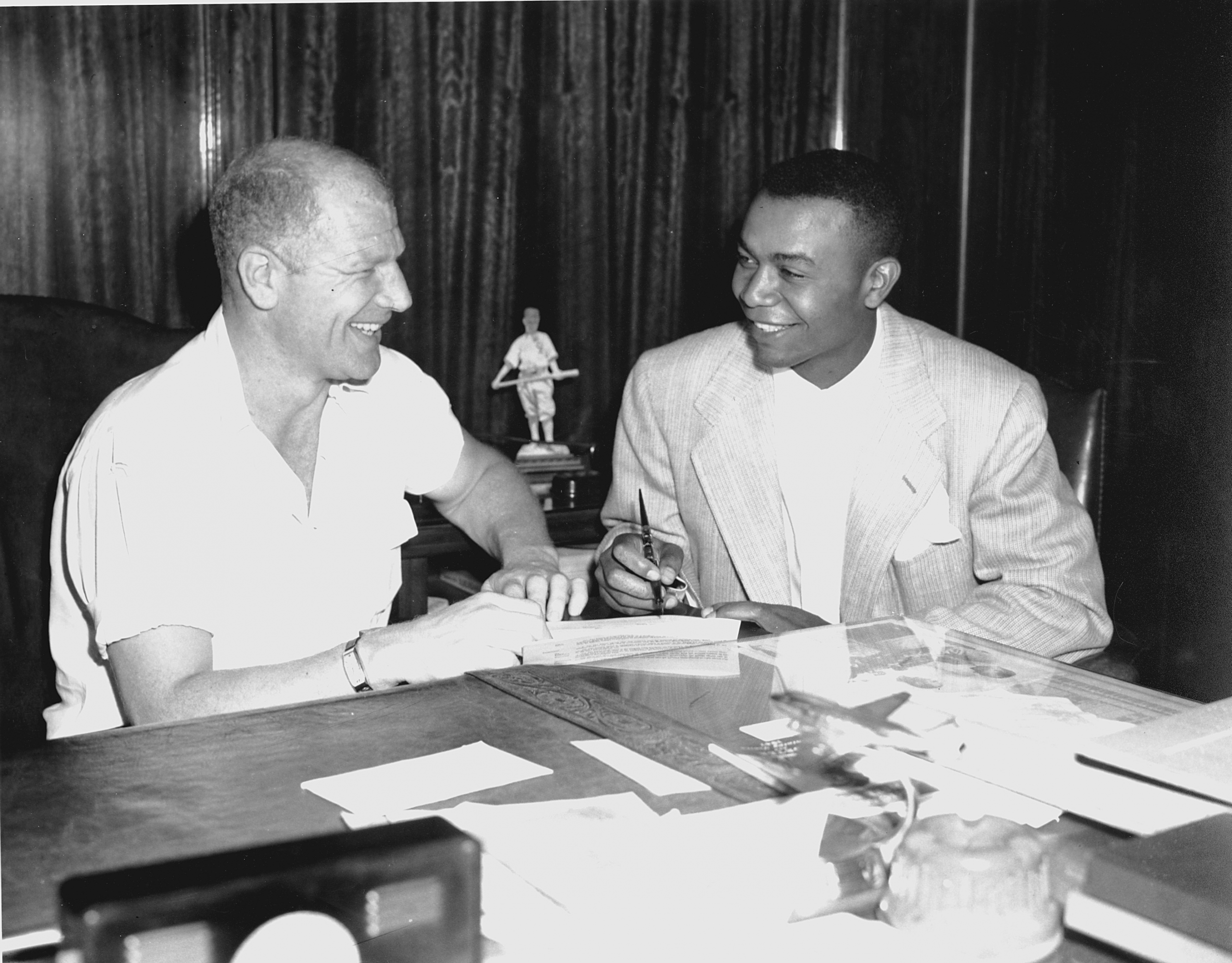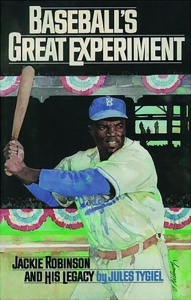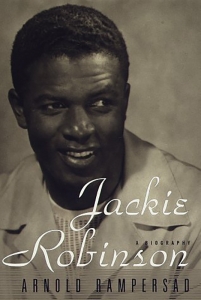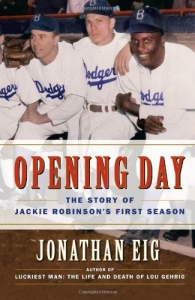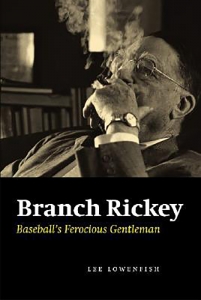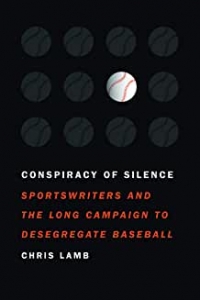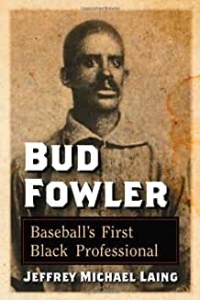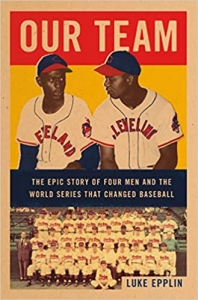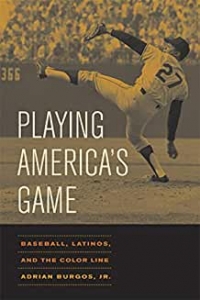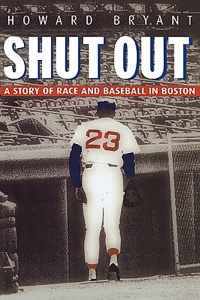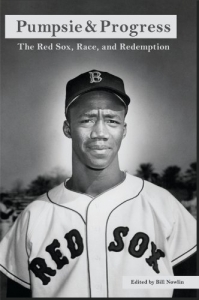After Jackie: Integration Pioneers in 1947 and Beyond
Larry Doby, right, the first African-American player in American League history, signed a major league contract with Cleveland Indians president Bill Veeck on July 5, 1947, then made his debut later that day. (ASSOCIATED PRESS)
Sixteen franchises conspired to segregate major-league baseball before 1947, but each team’s path to integration was an individual matter.
It was 16 American and National League clubs, acting largely on their own, making front-office and field-management decisions on 16 players (or 17, or 18), who integrated the majors between Jackie Robinson’s April 1947 debut with the Brooklyn Dodgers and Pumpsie Green’s July 1959 appearance with the Boston Red Sox.
Baseball’s integration includes as much “woulda, coulda, shoulda” as any aspect of the game’s history. Prominent laggards carry tales of how closely they missed becoming the vanguard. The Philadelphia Phillies, owned by Bill Veeck, fielding a team of Negro Leaguers in 1943? Robinson and Sam Jethroe working out at Fenway Park in 1945? Countless stories involving the Pittsburgh Pirates, fueled by all the Black baseball greatness around Pittsburgh in the 1930s and 1940s?
The actual instances of integration, presented in the 16 profiles below, reflect the points at which the demand to win — or intolerance of losing — and public pressure drove each team into baseball’s new era. Initial deployment of the pioneering players was varied, perhaps reflecting their teams’ attitudes towards integration. Some pioneers were in the lineup on Opening Day, or as soon as their teams signed them; others debuted away from the team’s home ballpark, as substitutes. It is notable that most of the teams who first embraced integration — the Dodgers, Indians, Giants, and Braves — were the only ones to break the Yankees’ championship stranglehold between 1947 and 1959.
Baseball’s integration was a long, complex process, not a singular moment. After Jackie Robinson’s first game in April 1947 at Ebbets Field, every time he traveled to play in a new ballpark in the National League he achieved a new first. When Larry Doby was signed by Cleveland in July, he began to integrate every American League ballpark, too. Over the next decade-plus, hundreds of other African American and Latino players integrated each of their minor league teams and towns, as well — sometimes as teenagers, sometimes with a language barrier, usually all by themselves in small, segregated towns. These players typically experienced none of the fanfare that Robinson received, but just as much animus in the Jim Crow era.
Once Green pinch-ran for the Red Sox, 4,480 days after Robinson’s first game in Brooklyn, the game’s racial ills were no more solved than America’s. But the National Pastime could now provide a more inclusive example to the rest of the country.
— John Fredland
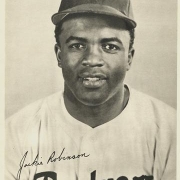
1. Jackie Robinson
Brooklyn Dodgers
April 15, 1947
Jackie Robinson’s much-anticipated debut with the Brooklyn Dodgers did not immediately open the floodgates to more Black players in the National League. The Dodgers signed pitcher Dan Bankhead from the Memphis Red Sox in August 1947 and assigned him to the major-league roster immediately. Future Hall of Fame catcher Roy Campanella came up in ’48 and pitcher Don Newcombe was selected to the All-Star team and earned Rookie of the Year honors in ’49. With such a head start in the talent pool, it’s no coincidence that the Dodgers won six NL pennants and the 1955 World Series over the next 10 decade.
- Jackie Robinson’s SABR biography, by Rick Swaine
- April 15, 1947 game recap, by Lyle Spatz

2. Larry Doby
Cleveland Indians
July 5, 1947
If Jackie Robinson’s debut had been the culmination of meticulous plans spread out over parts of three seasons, Larry Doby’s debut — 11 weeks into the 1947 season — was a whirlwind. He homered in his final game with the Newark Eagles on the Fourth of July. Then he took an overnight train to Chicago where he signed his contract with Cleveland president Bill Veeck. Later that day, he became the first Black player in American League when he pinch-hit for pitcher Bryan Stephens. Doby, whose new teammates kept their distance at first, struggled in his first season, hitting .156 in 29 games. But he won the starting job at center field in 1948 and helped lead the Indians to a World Series championship on his way to a Hall of Fame career.
- Larry Doby’s SABR biography, by John McMurray
- July 5, 1947 game recap, by Vince Guerrieri
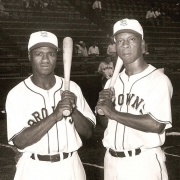
3. Hank Thompson, Willard Brown
St. Louis Browns
July 17, 1947
Three days after drawing a mere 478 fans to Sportsman’s Park against the Washington Senators, the St. Louis Browns made a surprising announcement: they were signing Hank Thompson and Willard Brown of the Kansas City Monarchs and bringing both Negro League stars directly to St. Louis to become the first modern team with multiple Black players. As the southernmost city in the AL and NL, St. Louis had been the last city to desegregate its ballpark to fans, just three years earlier in 1944. Thompson, a 21-year-old second baseman, and Brown, a 32-year-old established star and future Hall of Famer, spent just one month with the Browns before returning to the Monarchs.
- Hank Thompson’s SABR biography, by Rick Swaine
- Willard Brown’s SABR biography, by Rory Costello
- July 17, 1947 game recap, by Andrew Harner
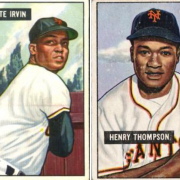
4. Monte Irvin, Hank Thompson
New York Giants
July 8, 1949
In his first year with the Giants, manager Leo Durocher tapped the Negro Leagues for talent by signing 23-year-old Hank Thompson from the Kansas City Monarchs and 30-year-old Monte Irvin from the Newark Eagles. They began the season with the Triple-A Jersey City Giants and were called up at the same time in early July. When Thompson stepped to the plate to face the Dodgers’ Don Newcombe in his first at-bat, they made history as the first Black pitcher and Black hitter to face each other in National League history. (A Black catcher, Roy Campanella, was also behind the plate.) Thompson and Irvin remained with the Giants to help them win the 1951 NL pennant and 1954 World Series.
- Monte Irvin’s SABR biography, by Larry Hogan
- Hank Thompson’s SABR biography, by Rick Swaine
- July 8, 1949 game recap, by Steven C. Weiner
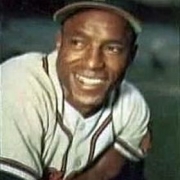
5. Sam Jethroe
Boston Braves
April 18, 1950
Five years before making his debut with the Boston Braves, Sam Jethroe tried out for the Red Sox at Fenway Park, along with Jackie Robinson and Marvin Williams. But the Red Sox pursued none of them. By the time he returned to Boston with the Braves, Jethroe was already a 10-year veteran of the Negro Leagues, a four-time All-Star outfielder with the Cleveland Buckeyes. He was 33 years old when he made his National League debut, homering off Kirby Higbe in the eighth inning. Jethroe won NL Rookie of the Year honors after hitting 18 home runs and stealing a league-leading 35 bases.
- Sam Jethroe’s SABR biography, by Bill Nowlin
- April 18, 1950 game recap, by Jack Zerby
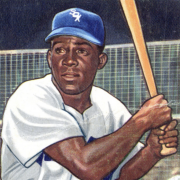
6. Minnie Miñoso
Chicago White Sox
May 1, 1951
A two-time All-Star in the Negro National League who had led the New York Cubans to the 1947 World Series crown, the Cuban-born Miñoso was signed by Cleveland’s Bill Veeck and made his American League debut in 1949. He spent the 1950 season in Triple-A, then was traded to the Chicago White Sox in a blockbuster deal just after Opening Day. In his first plate appearance with the White Sox, Miñoso blasted a long home run off the Yankees’ Vic Raschi but his heroics were overshadowed by Mickey Mantle’s first career home run in the same game. Miñoso made his first All-Star team in 1951, led the AL with 14 triples and 31 steals, and became a fan favorite in Chicago for the rest of his life. He was elected to the Baseball Hall of Fame in 2022.
- Minnie Miñoso’s SABR biography, by Mark Stewart
- May 1, 1951 game recap, by Mark S. Sternman
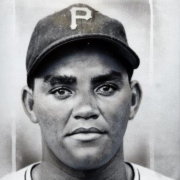
7. Carlos Bernier
Pittsburgh Pirates
April 22, 1953
A Puerto Rican outfielder with game-changing speed, Bernier rose to the major leagues after tying the Pacific Coast League record for stolen bases in a season. He made his debut with the Pirates as a pinch-hitter at Forbes Field, represented the team (alongside the Dodgers’ Jackie Robinson, Roy Campanella, and Joe Black) at Little League opening day ceremonies in Pittsburgh’s oldest Black neighborhood, and started regularly through July until his average dipped below .220. Bernier was in spring training with the Pirates in 1954 and 1955, but never played in the majors again. Texas-born Curt Roberts joined the team in 1954, started at second base on Opening Day, and eventually gained mainstream recognition as the Pirates’ first Black player.
- Carlos Bernier’s SABR biography, by Charles F. Faber
- April 22, 1953 game recap, by John Fredland
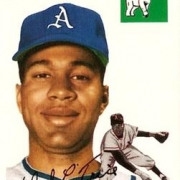
8. Bob Trice
Philadelphia A’s
September 13, 1953
27-year-old Bob Trice was called up by the Philadelphia A’s following a successful season at Triple-A Ottawa, where he was on his way to winning both Rookie of the Year and Most Valuable Pitcher awards in the International League. One of Trice’s former teammates and mentors, Satchel Paige, was in uniform with the St. Louis Browns for his debut. Trice showed flashes of brilliance before he was lifted for a pinch-hitter in the eighth inning in a 5-2 loss, and he turned more heads by winning his final two starts in September. But Trice became increasingly unhappy at the team’s lack of support following incidents of racial intolerance. He moved to Kansas City with the A’s in 1955, but was sent down to Triple-A in midseason and finished his career in the Mexican League.
- Bob Trice’s SABR biography, by Jack Morris
- September 13, 1953 game recap, by Gary Belleville
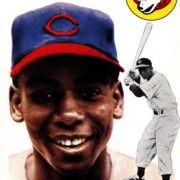
9. Ernie Banks
Chicago Cubs
September 17, 1953
Appearing at Wrigley Field for the first time in a Cub uniform, Banks became the first African American to play for the 77-year-old Chicago franchise. Back in the nineteenth century, Cap Anson, the legendary Cub first baseman and captain, set an early exclusionary tone by refusing to play teams with Black players. By 1954, the executive director of the Chicago Urban League described Chicago as “the most residentially segregated city in the United States.” Into this environment stepped a 22-year-old Dallas native who went on to become known as Mr. Cub. Banks went 0-for-3 in his debut, scoring one run and making an error at shortstop. Over the next two decades, he broke Anson’s club record for games played, and still ranks No. 1 in Cubs history in total bases and and extra-base hits.
- Ernie Banks’s SABR biography, by Joseph Wancho
- September 17, 1953 game recap, by Steve Dunn
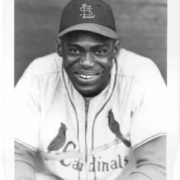
10. Tom Alston
St. Louis Cardinals
April 13, 1954
Acquired from the San Diego Padres of the Pacific Coast League in January for $100,000 and two players, Tom Alston arrived in St. Louis with the highest price tag ever for a player from that circuit. While there were 13 other Black players in the Cardinals system during spring training in 1954, at the close of preseason workouts the 28-year-old Alston became the first to make the organization’s big-league roster. Alston, who went 0-for-4, appeared in only 25 more major-league games over the next three seasons. Nonetheless, he opened the door to a wave of Black players – with Curt Flood arriving in 1958 and Bob Gibson a season later – that would thrill Cardinals fans to this day.
- Tom Alston’s SABR biography, by Warren Corbett
- April 13, 1954 game recap, by Doug Feldmann
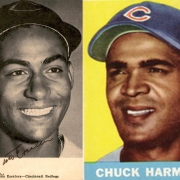
11. Nino Escalera, Chuck Harmon
Cincinnati Reds
April 17, 1954
It took decades for the first Black man to play for the Cincinnati Reds. The second one arrived merely minutes after the first. Despite being very early to appreciate the quality of white Cuban players — Armando Marsans, Rafael Almeida, Mike González, and Dolf Luque all debuted for the club in the 1910s — the team still had not yet fielded a dark-skinned man seven years after Jackie Robinson’s debut. In the third game of the 1954 season, Escalera and Harmon made their debuts as consecutive pinch-hitters in the seventh inning, a humble beginning for a franchise that would ultimately feature Hall of Famers Frank Robinson, Joe Morgan, and Barry Larkin among its all-time greats.
- Nino Escalera’s SABR biography, by Tony Oliver
- Chuck Harmon’s SABR biography, by J.P. Garrett
- April 17, 1954 game recap, by Tony Oliver
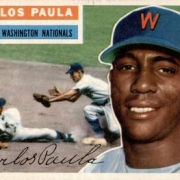
12. Carlos Paula
Washington Senators
September 6, 1954
Carlos Paula’s first appearance, in an end-of-season doubleheader, was the end of a long journey for Senators owner Clark Griffith. For three decades he had eagerly signed Black Cuban players to professional contracts and leased his ballpark to Negro League teams, but staunchly opposed allowing them to play in the major leagues. Paula was one of more than three dozen Cubans signed to a Senators contract by legendary scout Joe Cambria. In his debut against the Philadelphia A’s, Paula scorched an RBI double in his second at-bat. He spent parts of three seasons with the Senators, later returned home to Cuba and was jailed by revolutionary forces, but returned to live a largely anonymous life in the United States.
- Carlos Paula’s SABR biography, by Darren Gibson
- September 6, 1954 game recap, by Paul E. Doutrich
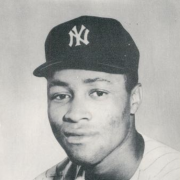
13. Elston Howard
New York Yankees
April 14, 1955
While the Dodgers and Giants already had established Black stars, the Yankees dragged their feet on signing any significant players of color during their dynasty years. Jackie Robinson even called out the team directly during a TV appearance. Elston Howard signed with the Kansas City Monarchs in 1948 before joining the Yankees organization one year later, where he was blocked at catcher by future Hall of Famer Yogi Berra. He was named MVP of the International League in 1954 and the Yankees called him up to make his debut in 1955. Howard later earned an AL MVP award in 1963, helping to win four World Series and 11 pennants with the Monarchs, Yankees, and Boston Red Sox.
- Elston Howard’s SABR biography, by Cecilia Tan
- April 14, 1955 game recap, by Dan Cichalski
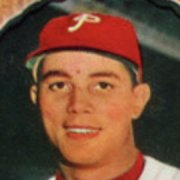
14. Chico Fernández
Philadelphia Phillies
April 16, 1957
Humberto “Chico” Fernández was one of the Brooklyn Dodgers’ top prospects for several years before making his major-league debut in 1956 in the wake of Don Zimmer’s beaning. The Phillies acquired the Cuban shortstop in a trade and started him on Opening Day 1957, a full decade after Jackie Robinson broke the color barrier. Six days later, John Kennedy became the first African American player to appear in a Phillies uniform when he entered as a pinch-runner. Fernández, who hit .240 over parts of eight seasons with the Dodgers, Phillies, Tigers, and Mets, played with a flair that endeared him to fans, but not always managers.
- Chico Fernández’s SABR biography, by Russ Walsh
- John Kennedy’s SABR biography, by Michael Marsh
- April 16, 1957 box score
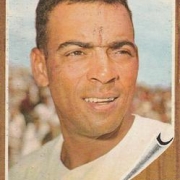
15. Ozzie Virgil
Detroit Tigers
June 6, 1958
Ozzie Virgil was the first Dominican to play in the major leagues, as well as the first player of color for the Detroit Tigers. He signed with the New York Giants in 1953 as a third baseman and made his major-league debut in 1956 at the Polo Grounds. He played in 96 games in 1957 before he was traded to the Tigers in the offseason. A Black newspaper in Detroit planned a protest of the team’s failure to promote any non-White players, and Virgil was recalled on June 6. In his home debut 11 days later, he went 5-for-5 and earned a standing ovation. His son Ozzie Jr. later became a two-time All-Star catcher.
- Ozzie Virgil’s SABR biography, by Ryan Brecker
- June 6, 1958 game recap, by Kurt Blumenau
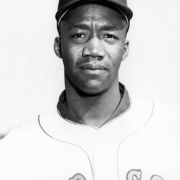
16. Pumpsie Green
Boston Red Sox
July 21, 1959
Twelve years after Jackie Robinson’s debut, the Red Sox stood out as the last major-league team not to field an African American ballplayer. Elijah Green, a 25-year-old middle infielder from Oakland, California, was a “reluctant pioneer.” He spent parts of seven seasons in the minor leagues and suffered through a stressful spring training in Arizona where he had to live in the Cubs’ integrated hotel rather than the Red Sox’s still-segregated quarters. Boston finally called up Green in mid-July and sent him into a game as a pinch-runner against the White Sox. He hit .246 over five seasons with the Red Sox and Mets before injuries curtailed his career.
- Pumpsie Green’s SABR biography, by Bill Nowlin
- July 21, 1959 game recap, by Bill Nowlin
Further Reading
Check out more books from SABR authors on Jackie Robinson and the integration of baseball:



